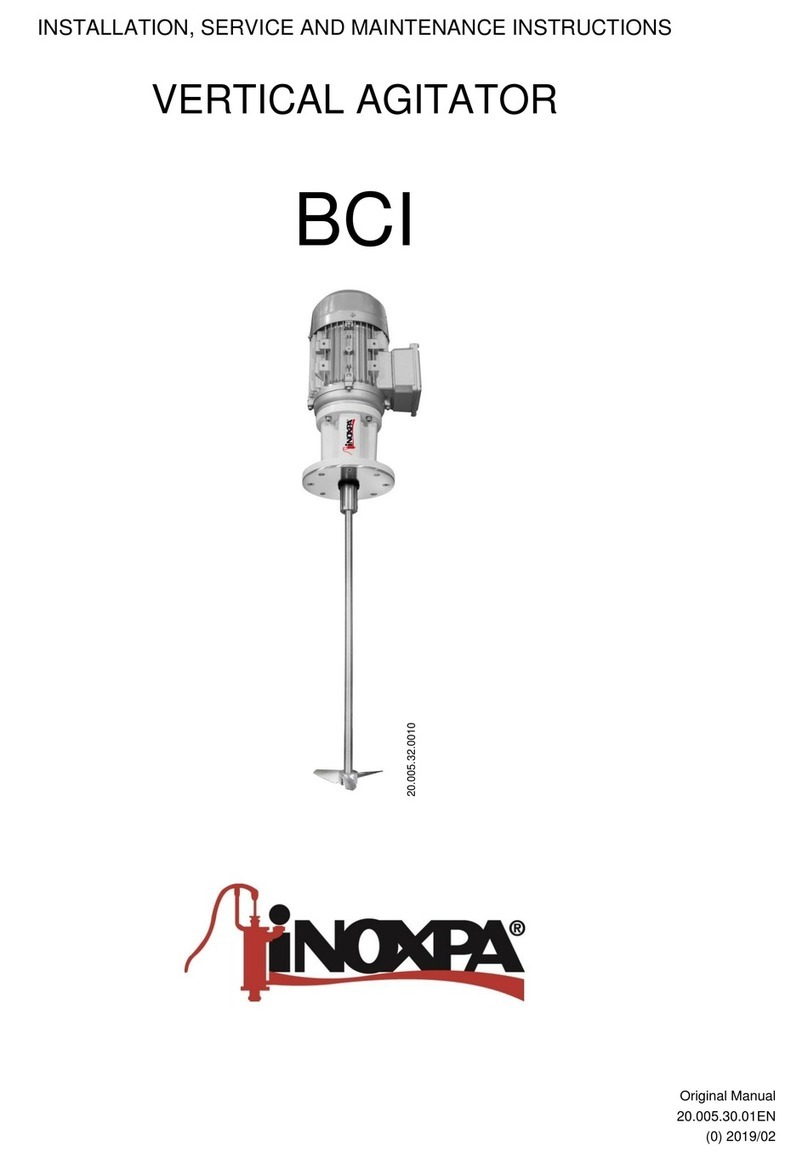INOXPA INNOVA Mini N Manual

SINGLE SEAT VALVE
INNOVA Mini N / K
Original Instructions
10.260.30.01EN
(A) 2022/09
INSTALLATION, SERVICE AND MAINTENANCE INSTRUCTIONS
10.260.32.0002
10.260.32.0003

E C D e c l a r a t i o n o f C o n f o r m i t y
Model:
INOXPA S.A.U.
Telers, 60
17820 - Banyoles (Spain)
hereby declare under our sole responsibility that the
Type:
Serial number:
INNOVA Mini
N / K
Technical Oce Manager
2nd June 2022
10.260.30.02EN
(0) 2022/06
Document:
Revision:
Machine: SINGLE SEAT VALVE
David Reyero Brunet
fullls all the relevant provisions of the following directive:
Machinery Directive 2006/42/EC
Pressure Equipment Directive 2014/68/EU1
Regulation (EC) nº 1935/2004
Regulation (EC) nº 2023/2006
and with the following harmonized standards and/or regulations:
EN ISO 12100:2010, EN ISO 13732-1:2008, EN 1672-2:2005+A1:2009,
EN ISO 14159:2008, EN 12266-1:2012, EN 19:2016
The technical le has been prepared by the signer of this document.
Size: DN 10 - DN 15 - DN 20 / OD ½’’ - OD ¾’’
IXXXXXXXXX to IXXXXXXXXX
XXXXXXXXXIINXXX to XXXXXXXXXIINXXX
1
Designed and manufactured in accordance with the sound engineering practice

D e c l a r a t i o n o f C o n f o r m i t y
Model:
INOXPA S.A.U.
Telers, 60
17820 - Banyoles (Spain)
hereby declare under our sole responsibility that the
Type:
Serial number:
INNOVA Mini
N / K
Technical Oce Manager
2nd June 2022
10.260.30.03EN
(0) 2022/06
Document:
Revision:
Machine: SINGLE SEAT VALVE
David Reyero Brunet
fulls all the relevant provisions of these regulations:
and with the following designated standards:
EN ISO 12100:2010, EN ISO 13732-1:2008, EN 1672-2:2005+A1:2009,
EN ISO 14159:2008, EN 12266-1:2012, EN 19:2016
The technical le has been prepared by the signer of this document.
Size: DN 10 - DN 15 - DN 20 / OD ½’’ - OD ¾’’
IXXXXXXXXX to IXXXXXXXXX
XXXXXXXXXIINXXX to XXXXXXXXXIINXXX
Supply of Machinery (Safety) Regulations 2008
Pressure Equipment (Safety) Regulations 20161
1
Designed and manufactured in accordance with the sound engineering practice

1. Table of Contents
1. Table of Contents
2. Generalities
2.1. Instructions manual.................................................................................................................................6
2.2. Compliance with the instructions ............................................................................................................6
2.3. Warranty..................................................................................................................................................6
3. Safety
3.1. Warning symbols..................................................................................................................................... 7
3.2. General safety instructions .....................................................................................................................7
4. General Information
4.1. Description ..............................................................................................................................................9
4.2.Application...............................................................................................................................................9
5. Installation
5.1. Reception of the valve ..........................................................................................................................10
5.2.Transport and storage...........................................................................................................................10
5.3. Identication of the valve ......................................................................................................................10
5.4. Location ................................................................................................................................................12
5.6. Direction of ow ....................................................................................................................................12
5.5. General installation ...............................................................................................................................12
5.7. Checking and review............................................................................................................................. 13
5.8. Welding .................................................................................................................................................13
5.9. Valve conguration with actuator ..........................................................................................................14
5.10. Connecting the air to actuator.............................................................................................................14
6. Start-up
7. Operating problems
8. Maintenance
8.1. General considerations .........................................................................................................................17
8.2. Maintenance .........................................................................................................................................17
8.3. Cleaning................................................................................................................................................18
8.4. Disassembly and assembly the valve ...................................................................................................20
8.5. Replacing the seat seal......................................................................................................................... 22
8.6. Actuator conguration ...........................................................................................................................23
9. Technical Specications
9.1. Valve
9.2.Actuator.................................................................................................................................................24
9.3. Materials ...............................................................................................................................................24
9.4. Sizes available ......................................................................................................................................24
9.5. Weights of the INNOVA Mini N and INNOVA Mini K valve ................................................................... 25
9.6. Dimensions of the INNOVA Mini N and INNOVA Mini K valve.............................................................. 25
9.7. Exploded drawing and parts list of the INNOVA Mini N valve ............................................................... 26
9.8. Exploded drawing and parts list of the INNOVA Mini K valve ............................................................... 27

2. Generalities
2.1. INSTRUCTIONS MANUAL
This manual contains information about the reception, installation, operation, assembly and mainte-
nance of INNOVA Mini N and INNOVA Mini K valve.
Carefully read the instruction prior to starting the valve, familiarize yourself with the installation, ope-
ration and correct use of the valve and strictly follow the instructions. These instructions should be
kept in a safe location near the installation area.
The information published in the instruction manual is based on updated data.
INOXPA reserves the right to modify this instruction manual without prior notice.
2.2. COMPLIANCE WITH THE INSTRUCTIONS
Not following the instructions may impose a risk for the operators, the environment and the machine,
and may cause the loss of the right to claim damages.
This non-compliance may cause the following risks:
- failure of important machine/plant functions,
- failure of specic maintenance and repair procedures,
- possible electrical, mechanical and chemical hazards,
- risk to the environment due to the type of substances released.
2.3. WARRANTY
The conditions of the warranty are specied in the General Sales Condition that has been delivered
at the time of placing your order.
The machine may not undergo any modication without prior approval from the manu-
facturer.
For your safety, only use original spare parts and accessories. The usage of other parts
will relieve the manufacturer of any liability.
Changing the service conditions can only be carried out with prior written authorization
from INOXPA.
Please do not hesitate to contact us in case of doubts or if further explanations are required regar-
ding specic data (adjustments, assembly, disassembly, etc.).
Generalities
5
INOXPA S.A.U. 10.260.30.01EN · (A) 2022/09

3.1. WARNING SYMBOLS
3. Safety
Safety hazard for people in general and/or equipment
ATTENTION Important instruction to prevent damage to the equipment and/or its function
3.2. GENERAL SAFETY INSTRUCTIONS
Read the instruction manual carefully before installing and starting the valve. Contact
INOXPA in case of doubt.
3.2.1. During installation
Always take into account the Technical Specications of chapter 9.
The installation and use of the valve should always be in accordance with applicable
regulations regarding health and safety.
Before starting up the valve, check that it is assembled correctly and its shaft is perfectly
aligned. Incorrect alignment and/or excessive stress during coupling can cause serious
mechanical problems in the valve.
3.2.2. During operation
Always take into account the Technical Specications of chapter 9.
NEVER exceed the specied limit values.
NEVER touch the valve and/or piping that is in contact with the uid during operation. If
the process involves hot products there is a risk of burns.
The valve contains parts that move in a linear fashion. Do not place hands or ngers in
the valve closing area. This can cause serious injury.
3.2.3. During maintenance
Always take into account the Technical Specications of chapter 9.
NEVER disassemble or remove the valve until the pipes have been emptied. Bear in
mind that the uid in the pipe may be hazardous or extremely hot. Consult the regula-
tions in eect in each country for these cases.
Inside the actuator there is a spring with an applied load. The steps specied in this ma-
nual must be followed when performing maintenance operations to avoid injury.
Do not leave loose parts on the oor.
Safety
INOXPA S.A.U. 10.260.30.01EN · (A) 2022/09
6

4. General Information
The INNOVA Mini N single seat valve is a shut-o valve that is used to open or close sections of a
pipe. The INNOVA Mini K single seat valve is a divert valve to divert the product with a converging
ow.
Because these two types of valve are single seat valve, they only have one union that separates
the two lines of the pipe. This means that they are not suitable for separating incompatible products,
since if there is a failure in the union if may not be detected and the products could mix.
4.1. DESCRIPTION
4.2. APPLICATION
The INNOVA Mini N and INNOVA Mini K single seat valve are a sanitary and exible design for a
wide range of applications in the food, pharmaceutical, chemical and beverage industries.
The INNOVA Mini N valve is usually used for emptying, drainage or as a shut-o valve on a bypass
line.
The INNOVA Mini K valve is often used to supply CIP and on return lines.
10.260.32.0004
INNOVA Mini N INNOVA Mini K
General Information
7
INOXPA S.A.U. 10.260.30.01EN · (A) 2022/09

INOXPA is not liable for any deterioration of the material caused by its transport or unpac-
king.
5.1. RECEPTION OF THE VALVE
5. Installation
When receipt the valve, check to see whether all the parts listed on the delivery slip are present:
- complete valve
- its components if any are supplied,
- instruction manual.
INOXPA inspects all its equipment before packaging. However, it cannot guarantee that the mer-
chandise arrives at the user intact.
When unpacking the valve:
- remove any possible traces of packaging from the valve or its parts,
- inspect the valve or the parts that comprise it for possible damage incurred during shipping,
- take all possible precautions against damage to the valve and its components.
5.2. TRANSPORT AND STORAGE
The buyer or user shall be liable for assembly, installation, start-up and operation of the
valve.
Take all possible precautions when transport and storage the valve to avoid damage it and its com-
ponents.
5.3. IDENTIFICATION OF THE VALVE
Each valve is inscribed with its fabrication number. Indicate de fabrication number on all documents
to refer to the valve.
II 2D Ex h IIIB T85 ºC...T200 ºC Db
II 2G Ex h IIB T6...T3 Gb
Type
Air
Serial
Size
Year
C. TELERS, 60 - 17820 BANYOLES
GIRONA (SPAIN) . www.inoxpa.com
INOXPA S.A.U.
R
10.260.32.0018
Installation
INOXPA S.A.U. 10.260.30.01EN · (A) 2022/09
8

WA N L 0 - 0 06 52 015 20 0 B
Port lower orientation
A0⁰
B90⁰
C180⁰
D270⁰
Options
0 ID Ra < 0,8
1 ID Ra < 0,5
Actuator
10 T0 S/E NC
20 T0 D/E
30 T0 S/E NO
Size
010 DN 10
015 DN 15, OD ½’’
020 DN 20, OD ¾’’
Seals
43 HNBR
52 EPDM
78 FPM
Material
06 1.4404 (AISI 316L)
Connection
0 Welded
Standard pipe
0 DIN
1 OD
Bodies conguration
L,T INNOVA N
H,E,F,G INNOVA K
Type
Nshut-o valve (reverse acting)
Krouting (converging ow)
Product family
WA INNOVA valve
Installation
9
INOXPA S.A.U. 10.260.30.01EN · (A) 2022/09

5.4. LOCATION
Place the valve leaving enough space around it to realize easily the dismantling, the inspection and
the review the valve as well as in order to access to the actuator air connection’s device for valves
with automatic actuation even when the valve is operating. Consult in chapter 5.8. Welding the re-
quired minimum distances. The installation should allow that the removable parts are could remove
easily.
5.5. GENERAL INSTALLATION
After the location of the valve is dened, the valve can be joined to the pipe by welding the valve
housing or using ttings.
In case of joining the valve to the pipe by ttings do not forget the seals and tighten the unions pro-
perly.
If instead, the valve is joined by welding, before starting to weld the valve bodies to the pipe disas-
semble the valve to prevent damage to the joints, following the instructions in chapter 8.4. Disas-
sembly and assembly the valve.
During installation, the valve avoids using excessive force and pay special attention to:
- vibrations that may be produced on the facility,
- thermal dilation that the pipe may undergo when hot uids are circulating,
- the weight that the pipe can support,
- excessive welding current.
The connections must be EHEDG-approved as described in EHEDG Position Paper (see www.
ehedg.org/guidelines).
5.6. DIRECTION OF FLOW
The following image indicates the recommended direction for product ow, as well as the direction of
closing, depending on the type of valve. Following these indications will prevent water hammer and
its consequences to the extent possible, which can occur when valves close.
The recommended direction will always be contrary to the movement of valve closing, that is, when
the valve is closing, the valve will always work against the pressure of the uid.
INNOVA Mini K
10.260.32.0006
INNOVA Mini N
10.260.32.0005
Due to design of the bodies, the valve is completely drainable in vertical position. In case of placing
the valve in other positions, horizontal or inclined, to assure the self-draining, install the valve with at
least the port that occupies the lowest position facing downwards.
Installation
INOXPA S.A.U. 10.260.30.01EN · (A) 2022/09
10

10.260.32.0007
5.7. CHECKING AND REVIEW
Perform the following checks before using the valve:
- check that the clamps and nuts are tightened,
- if the valve is tted with a pneumatic drive, apply the compressed air several times checking to
make sure that the valve carries out the opening and closing action without diculty.
5.8. WELDING
Welding work should only be done by qualied persons who are trained and equipped
with the necessary equipment to perform this kind of work.
All welded joint shall have full penetration, be free of pits, folds, crevices, cracks and misalignments;
and may have an as-welded interior surface nish as per AWS/ANSI D 18.1. The weld discoloration
in the as-welded condition shall be either weld 1, 2 or 3 as shown in AWS/ANSI D 18.2 or weld No
1,2,3,4, or 5 as shown in EHEDG Guideline 35.
To perform the welding works:
- disassemble the valve as indicated in chapter 8.4. Disassembly and assembly the valve,
- weld the valve body to the pipes maintaining the distance indicated in the following table,
dimension A. This will allow for disassembly of the valve, doing the subsequent reviews and
changing the necessary valve pieces like seals, bushings, etc.
DN A (mm)
10 290
15 285
20 285
½’’ 290
¾’’ 285
A
10.260.32.0008
Installation
11
INOXPA S.A.U. 10.260.30.01EN · (A) 2022/09

To perform the air connection to the actuator:
- connect and check the air connections (G 1/8’’ thread for tubing Ø6 mm) with thread in accor-
dance with double-eect or simple eect needs.
- mind the quality of the compressed air according to the specications described in chapter 9.
Technical Specications.
5.9. VALVE CONFIGURATION WITH ACTUATOR
5.10. CONNECTING THE AIR TO ACTUATOR
The standard conguration of the valves is NC (normally closed). However, is possible to convert
the valve into NO (normally open) by turning the valve actuator following the procedure described in
chapter 8.6. Actuator conguration.
The valves can also be congured as DE valves (air-air).
Never disassemble the valve clamps directly without reading the instructions carefully
since the actuator contain a spring inside it with an applied load.
Valve assembly and disassembly should only be done by qualied persons.
Depending on the conguration, the actuator may have one or two air connections.
10.260.32.0035
Installation
INOXPA S.A.U. 10.260.30.01EN · (A) 2022/09
12

6. Start-up
Read carefully the instructions in chapter 5. Installation before start-up the valve.
Before putting the valve or the actuator into service the following must be taken into consideration:
- check that the piping and valve are completely free of possible traces of welding slag or other
foreign particles. Clean the system if is necessary,
- check to make sure the valve moves smoothly. If necessary, lubricate it with special grease or
soapy water,
- check for possible leaks, and make sure the pipes and their connections are sealed and do not
have any leaks,
- if the valve has been supplied with an actuator, make sure that the alignment of the valve shaft
and the actuator shaft enables smooth movement,
- check that the compressed air pressure at the inlet of the actuator matches what is indicated in
chapter 9. Technical Specications,
- consider the quality of the compressed air, according to the specications described in chapter
9. Technical Specications,
- activate the valve.
Before start-up, the persons in charge must be duly informed about how the valve works
and the safety instructions to follow. This instruction manual will be available to person-
nel at all times.
ATTENTION
Do not modify the operating parameters for which the valve has been designed without
prior written authorisation from INOXPA.
Do not touch the moving parts of the coupling between the actuator and the valve when
the actuator is connected to the compressed air supply.
¡Burn hazard! Do not touch the valve or the pipes when hot uids are circulating or when
cleaning and/or sterilization are being carried out.
Start-up
13
INOXPA S.A.U. 10.260.30.01EN · (A) 2022/09

7. Operating problems
Water hammer
Valve does not open/close
Internal leak of product (valve closed)
The valve plug is sticking
CAUSAS PROBABLES SOLUCIONES
•The seal or guide bushing is worn, deteriorated
or has gotten stuck
Replace the seals.
Replace the seals with ones made of a dierent
material or grade that is more appropriate for the
product.
Lubricate with soapy water or a lubricant that is
compatible with the seal material and the product.
•Insucient air pressure Increase the compressed air pressure.
• Normal wear of seals Replace the seals.
•Premature wear of the seal / aected by the
product
Replace the seals with ones made of a dierent
material or grade that is more appropriate for the
product.
Reduce the pressure in the line.
Reduce the working temperature.
•Product residue has been deposited on the
valve seat and/or plug Clean frequently.
• Excess product pressure
Connect an auxiliary compressed air nipple on the
side of the spring (to oset the excess pressure)
without exceeding 4 bar.
Reduce the product pressure.
•Loss of seal (vibrations) Tighten loose parts.
•Product pressure exceeds the actuator
specications
Reduce the product pressure.
Use auxiliary air on the spring side.
•Warping of seals Replace the seals with ones of a dierent quality,
if they have deteriorated prematurely.
•The direction of ow is the same as the direction
of closing
The direction of ow should go against the direc-
tion of closing.
Choke the air discharge to reduce the pressure.
Operating problems
INOXPA S.A.U. 10.260.30.01EN · (A) 2022/09
14

8. Maintenance
This valve, just like any other machine, requires maintenance. The instructions in this chapter cover
the maintenance of the valve, the identication and replacement of the spare parts and the disas-
sembly and assembly of the valve. The instructions are aimed at maintenance personnel and those
responsible for the supply of spare parts.
Read carefully the chapter 9. Technical Specications.
Maintenance work should only be done by qualied persons who are trained and equi-
pped with the necessary equipment to perform this kind of work.
All replaced material should be duly disposed or recycled according to the directives in
eect in each area.
Make sure that the pipes are not under pressure before starting maintenance work.
8.1. GENERAL CONSIDERATIONS
8.2. MAINTENANCE
To perform maintenance properly is recommended:
- periodic inspection of the valve and its components,
- keeping an operational record of each valve writing down any problems,
- always having spare replacement seals in stock.
Pay special attention to the hazard warnings indicated in this manual during the performance of the
maintenance work.
The valve and the pipes must never be under pressure during maintenance.
¡Burn hazard! Do not touch the valve or the pipes when hot uids are circulating or when
cleaning and/or sterilization are being carried out.
8.2.1. Maintenance of the seals
REPLACING SEAL
Preventive maintenance Replace after 12 months
Maintenance after a leak Replace at the end of the process
Planned maintenance
Regularly check the absence of leaks and the smooth ope-
ration of the valve.
Keep a record of the valve’s maintenance.
Use statistics for planning inspections.
Lubrication During assembly, apply lubricants that are suitable with the
material of which the seat seal is made
The time interval between each preventive maintenance may vary in accordance with the work con-
ditions to which the valve is subject: temperature, pressure, number of operations per day, type of
cleaning solutions used, etc.
SEAL COMPONENT LUBRICANT NLGI DIN
51818 Class
HNBR / FPM klübersynth UH 1 64-2403 3
EPDM / HNBR / FPM PARALIQ GTE 703 3
Maintenance
15
INOXPA S.A.U. 10.260.30.01EN · (A) 2022/09

8.2.2. Storage
The valves should be stored in a closed area under the following conditions:
- temperature between 15ºC y 30ºC,
- air humidity < 60%
Storage of the equipment in the open air is NOT allowed.
8.2.3. Spare parts
To request spare parts is necessary to indicate the type of valve, the size, the fabrication number,
the position and the description of the part which can be found in chapter 9. Technical Specications.
8.3. CLEANING
The use of aggressive cleaning products such as caustic soda and nitric acid may burn
the skin.
Wear rubber gloves during all cleaning procedures.
Always wear protective goggles.
ATTENTION
Check the concentration of the cleaning solutions. An incorrect concentrations may lead
to the deterioration of the valve seals.
To remove any traces of cleaning products, ALWAYS perform a nal rinse with clean water at the end
of the cleaning process.
Clean the entire interior and exterior of the valve before starting disassembly and assem-
bly tasks.
If the valve is installed in a system with a CIP process its disassembly will not be required. EPDM is
the standard seal material that will be used for CIP cleaning, both in alkaline mediums and in acid
mediums. The materials of the seal HNBR and FPM are not recommended.
Two types of solutions can be used for CIP processes:
a. alkaline solution: 1% by weight of caustic soda (NaOH) a 70ºC (150ºF). To make this solution:
1 kg NaOH + 100 l H2O1= cleaning solution
2,2 l NaOH al 33% + 100 l H2O = cleaning solution
b. acid solution: 0,5% by weight of nitric acid (HNO3) a 70ºC (150ºF). To make this solution:
0,7 l HNO3al 53% + 100 l H2O = cleaning solution
1) only use chlorine-free water to mix with the cleaning agents
8.3.1. CIP (clean-in-place) cleaning
ATTENTION
Do NOT start the equipment during the sterilization with steam.
The parts and the materials will not be damaged if the indications specied in this manual
are observed.
No cold uid can enter the equipment until the temperature of the equipment is lower
than 60°C (140°F).
Sterilization with steam is applied to all equipment including the pigging.
8.3.2. Automatic SIP (sterilization-in-place)
Maintenance
INOXPA S.A.U. 10.260.30.01EN · (A) 2022/09
16

Maximum conditions during the SIP process with steam or superheated water:
a. maximum temperature: 140ºC / 284ºF
b. maximum time: 30 min
c. cooling: sterile air or inter gas
d. materials: EPDM (the materials HNBR and FPM are not recommended)
Maintenance
17
INOXPA S.A.U. 10.260.30.01EN · (A) 2022/09

8.4. DISASSEMBLY AND ASSEMBLY THE VALVE
Proceed with caution. Personal injury can occur.
Always disconnect the compressed air before starting to disassemble the valve.
Never disassemble the valve clamps directly without reading the instructions carefully,
since the actuator contains a spring inside it with an applied load.
Valve and actuator assembly and disassembly should only be done by qualied persons.
The following tools are needed in order to disassembly and assembly the valve and the drives:
- two 10 mm crescent spanners
- appropiate tool (not piercing) to mount the seat seals.
8.4.1. Disassembly 8.4.2. Assembly
1. At the NC valves, apply compressed air to the
actuator (10) to the plug shaft (08) passes to the
open position.
2. Loosen and separate the clamp (34).
3. Separate the valve body (01) from the assem-
bled formed by the actuator (10) - lantern (21)
- plug shaft (08).
4. At the NC valves, release the compressed air
from the actuator (10).
5. Loosen the lower threaded guide (55A) from
the actuator (10) thus will allow the lantern to turn
freely.
6. Unscrew the plug shaft (08) from the actuator
(10) shaft with two 10 mm crescent spanners.
One of the crescent spanners will x the actuator
shaft for the upper part of the actuator and the
other one shall turn the plug shaft (08) to uns-
crew it.
7. Remove the body cover (12) from the shaft.
8. Separate the upper guide bushing (17), the
shaft seal (05) and the O-ring (20B) from the
body cover (12).
9. Unscrew and remove the lower threaded gui-
de (55A) from the actuator (10).
10.Separate the lantern (21).
11. Remove the conical seat seal (05C) from the
plug shaft (08) following the instructions in chap-
ter 8.5. Replacing the seat seal.
12.At the INNOVA Mini K valves, remove the ra-
dial seat seal (05D) following the instructions in
chapter 8.5. Replacing the seat seal.
1. Lubricate the seals with soapy water or suita-
ble grease to facilitate their assembly.
2. Mount the conical seat seal (05C) to the plug
shaft (08) following the instructions in chapter
8.5. Replacing the seat seal.
3. At the INNOVA Mini K valves, assemble the
radial seat seal (05D) to the plug shaft (08) fo-
llowing the instructions in chapter 8.5. Replacing
the seat seal.
4. Mount the seat seal (05) and the O-ring (20B)
to the body cover (12).
5. Place the guide bushing (17) on the body co-
ver (12).
6. Place the body cover (12) on the plug shaft
(08).
7. Place the lantern (21) on the actuator (10) and
x it with the lower threaded guide (55A) of the
actuator.
8. Thread the plug shaft (08) with the actuator
shaft (10).
9. At the NC valves, apply compressed air to
the actuator (10) to the plug shaft (08) passes to
the open position.
10. Mount the actuator (10) - lantern (21) - plug
shaft (08) assembly on the valve body (01) and
x it with the clamp (34). The body is steerable
360⁰, place it as the needs of the user.
11. At the NC valves, release the compressed air
from the actuator (10).
12. Open and close the valve several times appl-
ying compressed air to the actuator to make sure
it operates correctly and the shaft seal ts smoo-
thly with the valve body.
21
01
55A
55
10
34
08
21
01
10
Maintenance
INOXPA S.A.U. 10.260.30.01EN · (A) 2022/09
18

21
01
55A
55
10
INNOVA Mini N
21
01
55A
55
10
17
08
21
05C
05
20B
12
55A
1
2
3
05C
05D
08
05
17
20B
12
55A
21
10.260.32.0011
34
08
21
01
10
01
55A
21
10
55
1
2
3
INNOVA Mini K
10.260.32.0010
Maintenance
19
INOXPA S.A.U. 10.260.30.01EN · (A) 2022/09

8.5. REPLACING THE SEAT SEAL
1. Put the plug shaft in a vertical position –for example, with
a bench clamp- so that the shaft is kept stable and no da-
mage is caused to the mating surface of the conical seal.
Do not press the shaft too much if using a bench clamp.
2. Remove the used seal using a screw driver or a sharp
hook-shaped tool. Make sure not to damage the mating
surface of the seal.
3. Lubricate the new seat seal with soapy water if neces-
sary to facilitate installation.
4. Insert the seal in the plug shaft seat accommodation so
that its edges are inside the accommodation. Preferably,
the seal should t within the part of the section that has the
greatest diameter, as shown in the gure.
5. Then, with the help of an appropriate tool (not piercing),
press the edge of the seal that has not yet t into the ac-
commodation, as shown in the gure.
6. This operation should be done around the entire diame-
ter, applying the tool in the sequence 1-2-3-4-5-6-7-8 as
shown in the bottom gure. Always press on opposite si-
des. Once you get to the last step of this sequence, repeat
the process until the seal is completely inside the accom-
modation.
7. Press the seal with your ngers to make sure it is well
seated. Make sure there are no parts projecting due to the
poor positioning of the seal.
10.260.32.0036
INNOVA Mini N
10.240.32.0017
10.260.32.0038
10.260.32.0037
INNOVA Mini K
Maintenance
INOXPA S.A.U. 10.260.30.01EN · (A) 2022/09
20
This manual suits for next models
3
Table of contents
Other INOXPA Industrial Equipment manuals
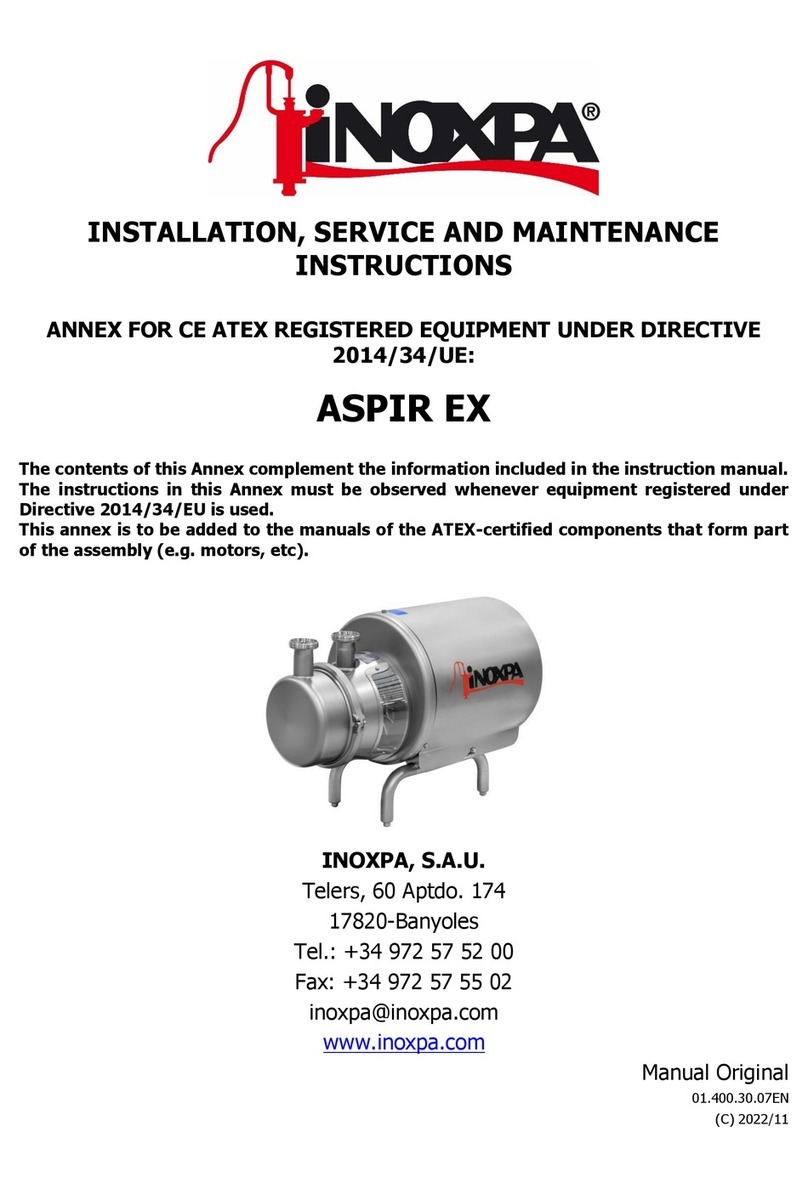
INOXPA
INOXPA ASPIR EX Manual

INOXPA
INOXPA KIBER KS Ex Manual
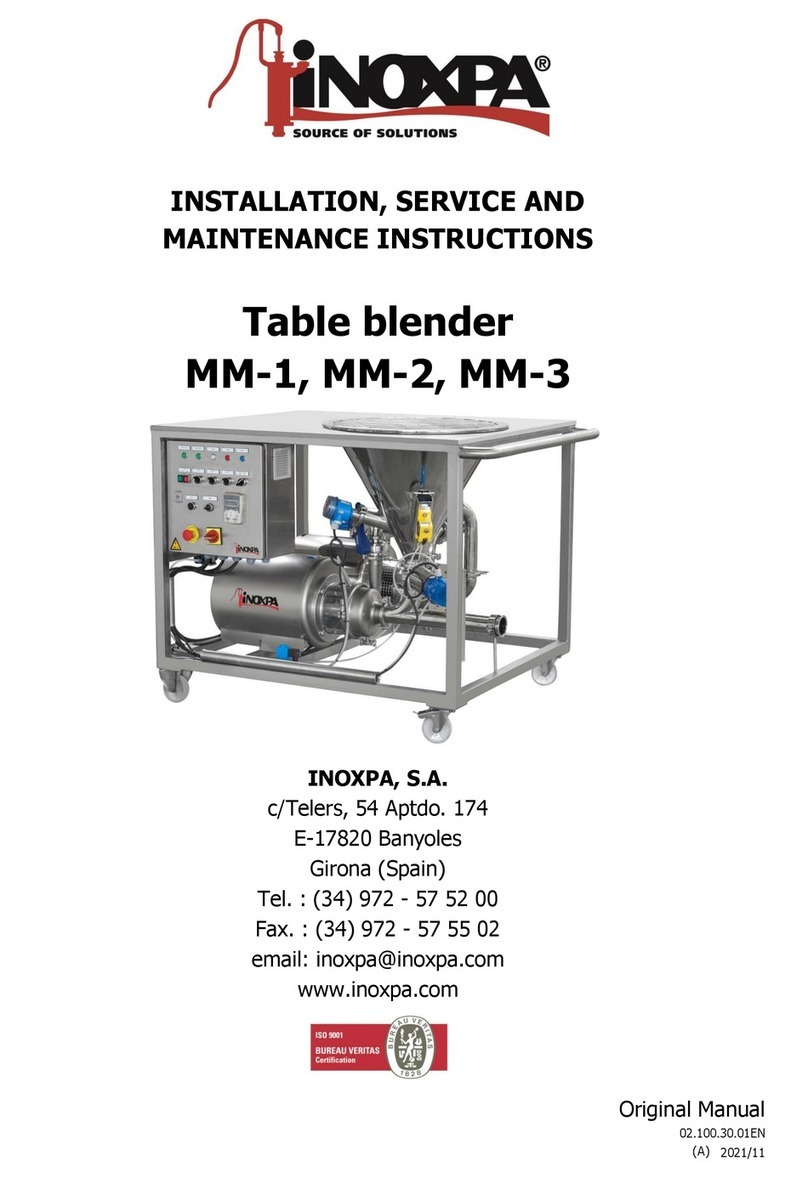
INOXPA
INOXPA MM-1 Manual

INOXPA
INOXPA KIBER KSF Ex Manual

INOXPA
INOXPA BFI Manual
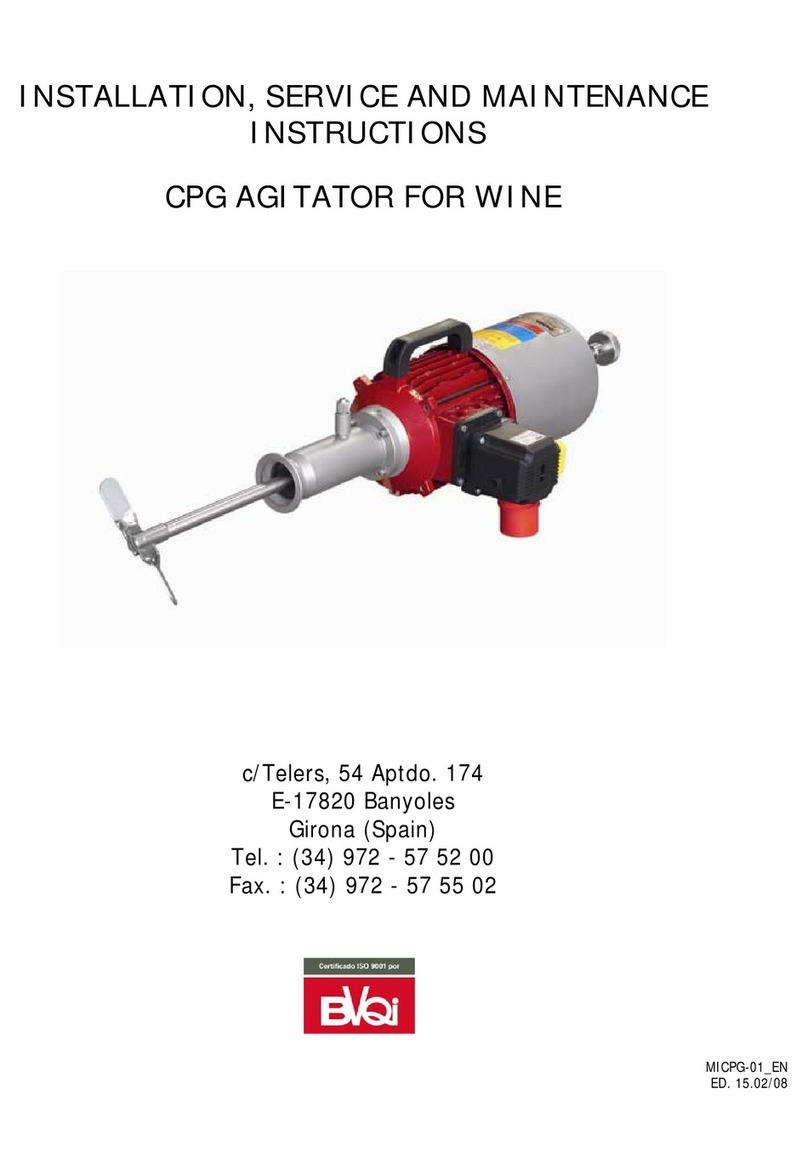
INOXPA
INOXPA CPG Series Installation and user guide
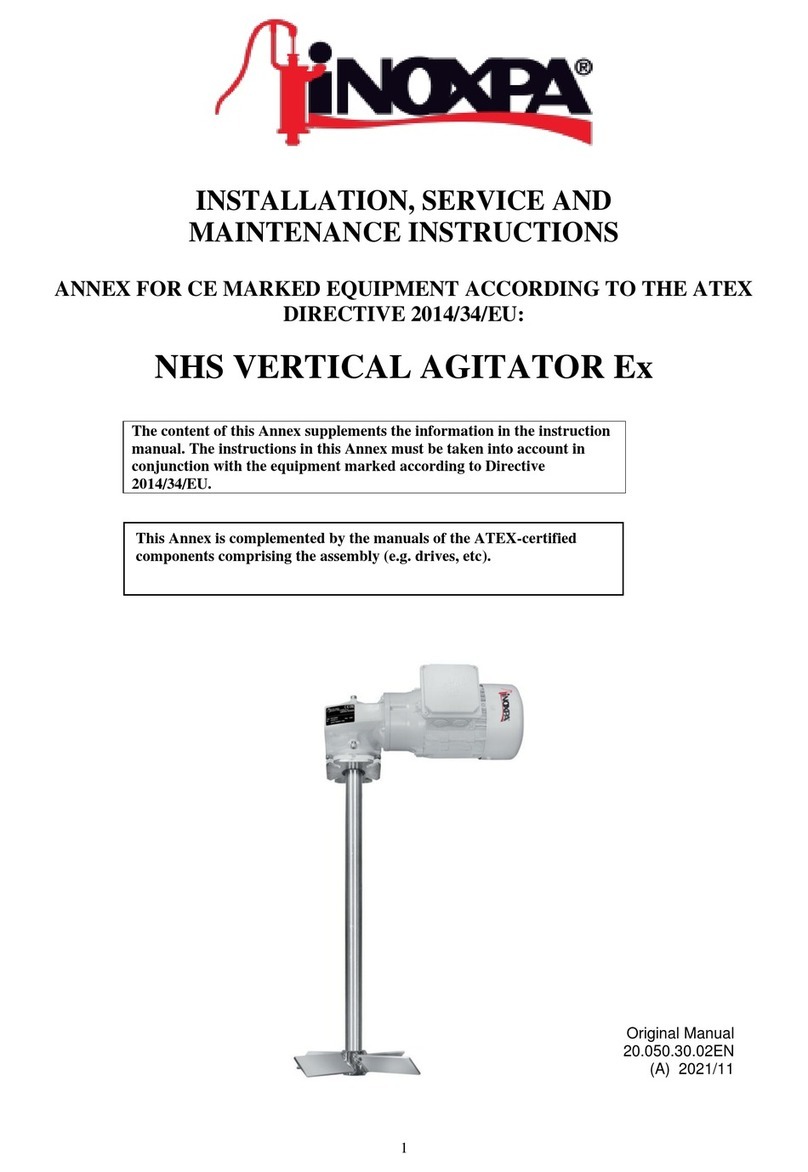
INOXPA
INOXPA NHS VERTICAL AGITATOR Ex Manual
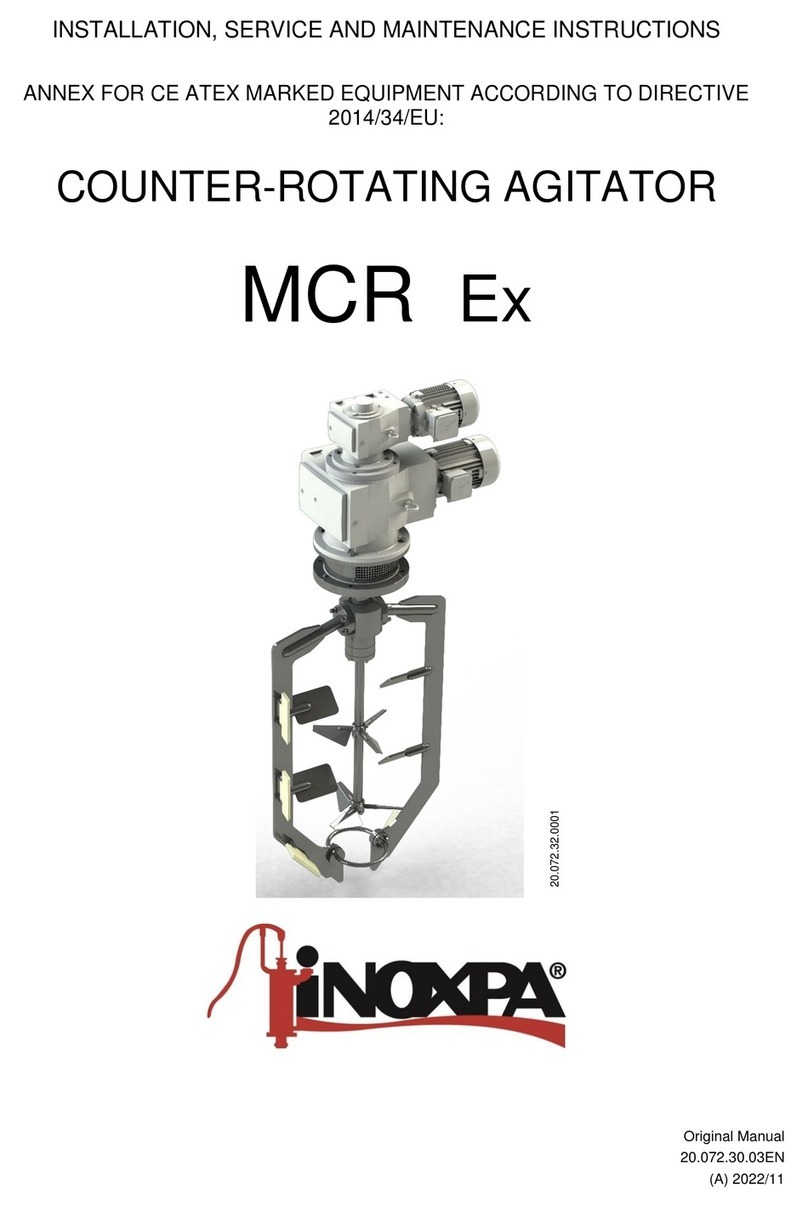
INOXPA
INOXPA MCR Ex Manual
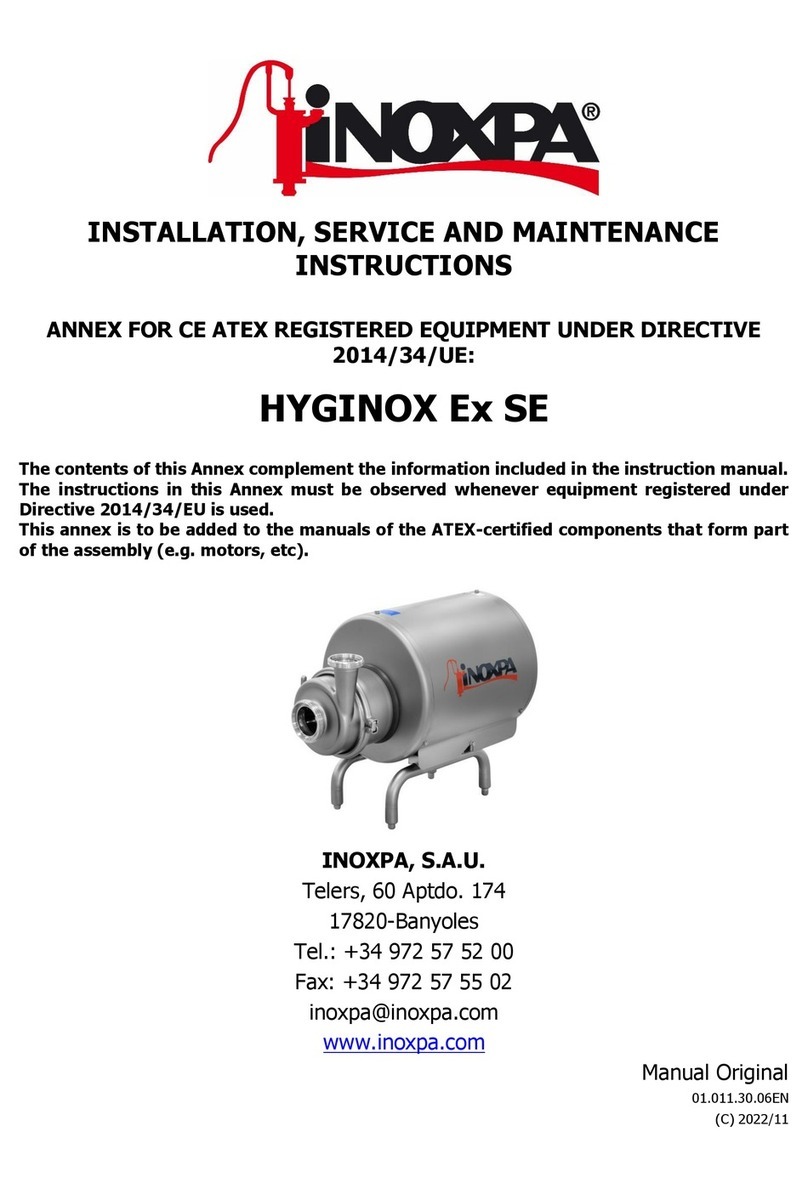
INOXPA
INOXPA HYGINOX Ex SE Manual
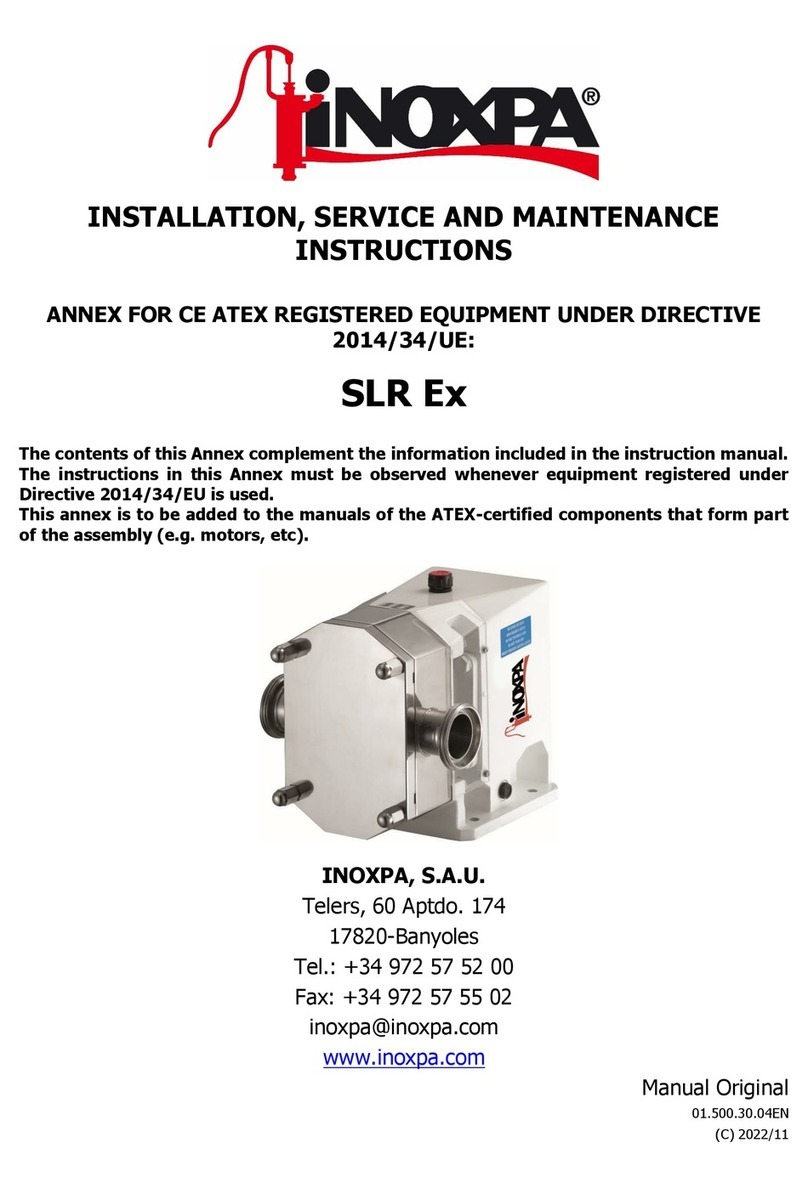
INOXPA
INOXPA SLR Ex Manual
